Abstract
To see whether antihistamines could prevent and reverse histamine-induced pulmonary edema and increased lung vascular permeability, we compared the effects of a 4-h intravenous infusion of 4 mug/kg per min histamine phosphate on pulmonary hemodynamics, lung lymph flow, lymph and plasma protein content, arterial blood gases, hematocrit, and lung water with the effects of an identical histamine infusion given during an infusion of diphenhydramine or metiamide on the same variables in unanesthetized sheep. Histamine caused lymph flow to increase from 6.0+/-0.5 to 27.0+/-5.5 (SEM) ml/h (P less than 0.05), lymph; plasma globulin concentration ratio to increase from 0.62+/-0.01 to 0.67+/-0.02 (P less than 0.05), left atrial pressure to fall from 1+/-1 to -3+/-1 cm H2O (P less than 0.05), and lung lymph clearance of eight protein fractions ranging from 36 to 96 A molecular radius to increase significantly. Histamine also caused increases in lung water, pulmonary vascular resistance, arterial PCO2, pH, and hematocrit, and decreases in cardiac output and arterial PO2. Diphenhydramine (3 mg/kg before histamine followed by 1.5 mg/kg per h intravenous infusion) completely prevented the histamine effect on hematocrit, lung lymph flow, lymph protein clearance, and lung water content, and reduced histamine effects on arterial blood gases and pH. 6 mg/kg diphenhydramine given at the peak histamine response caused lymph flow and lymph: plasma protein concentration ratios to fall. Metiamide (10 mg/kg per h) did not affect the histamine lymph response. We conclude that diphenhydramine can prevent histamine-induced pulmonary edema and can prevent and reverse increased lung vascular permeability caused by histamine, and that histamine effects on lung vascular permeability are H1 actions.
Full text
PDF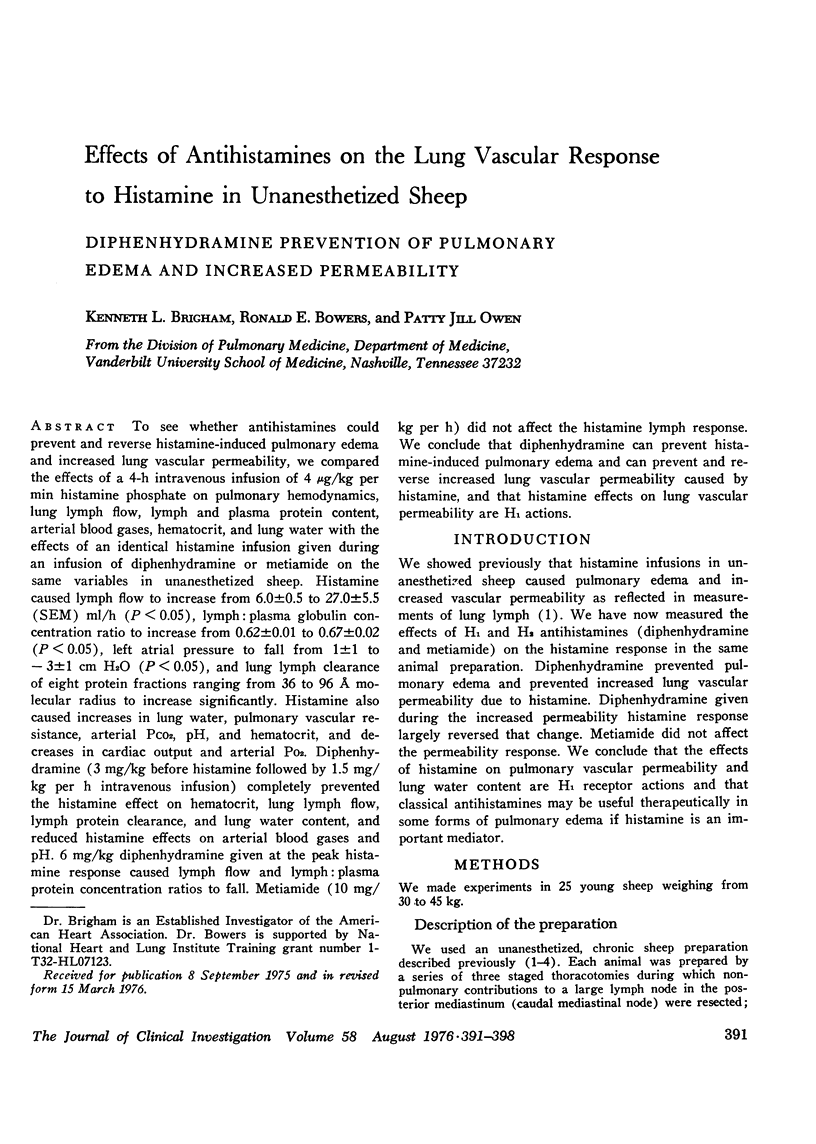

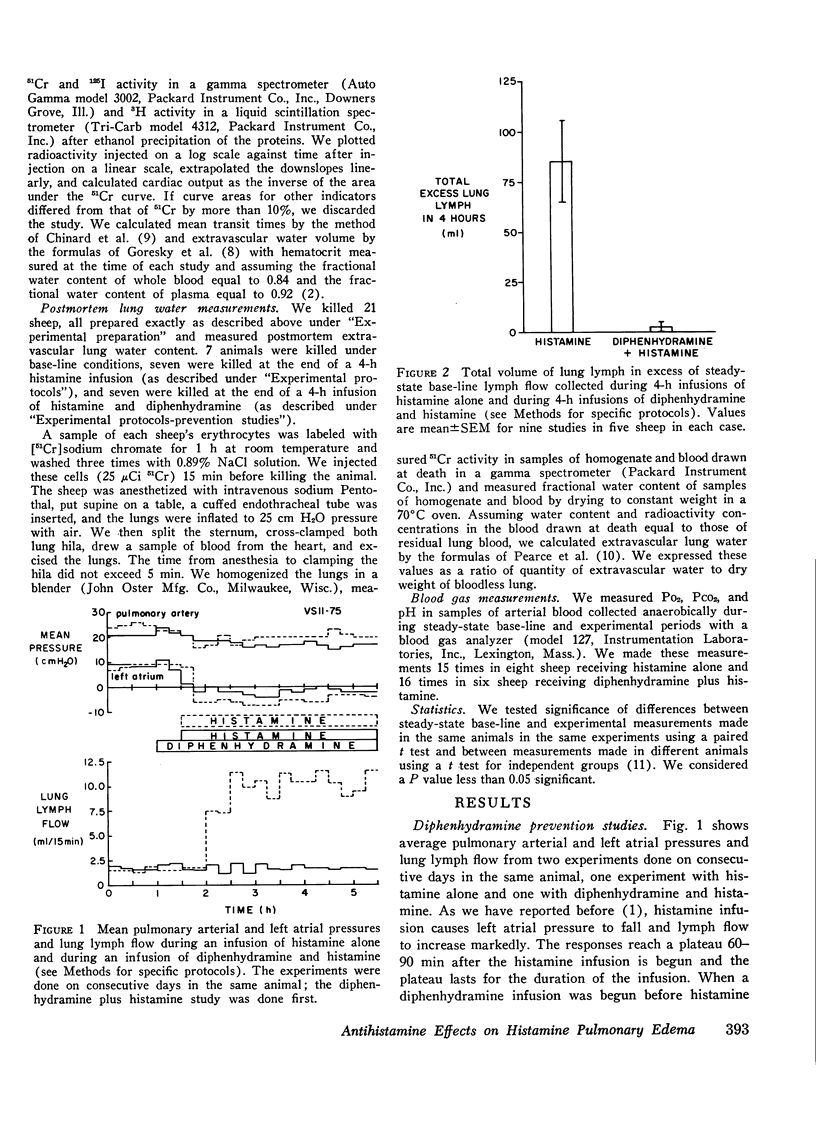
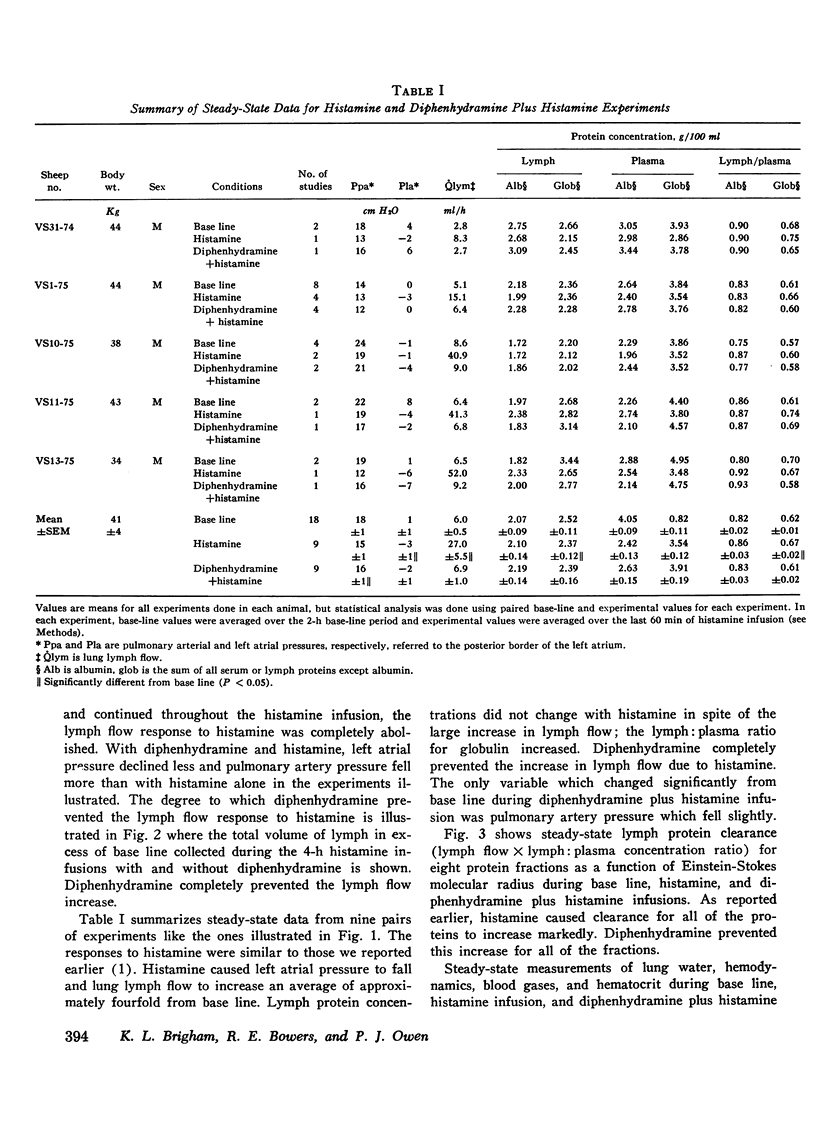

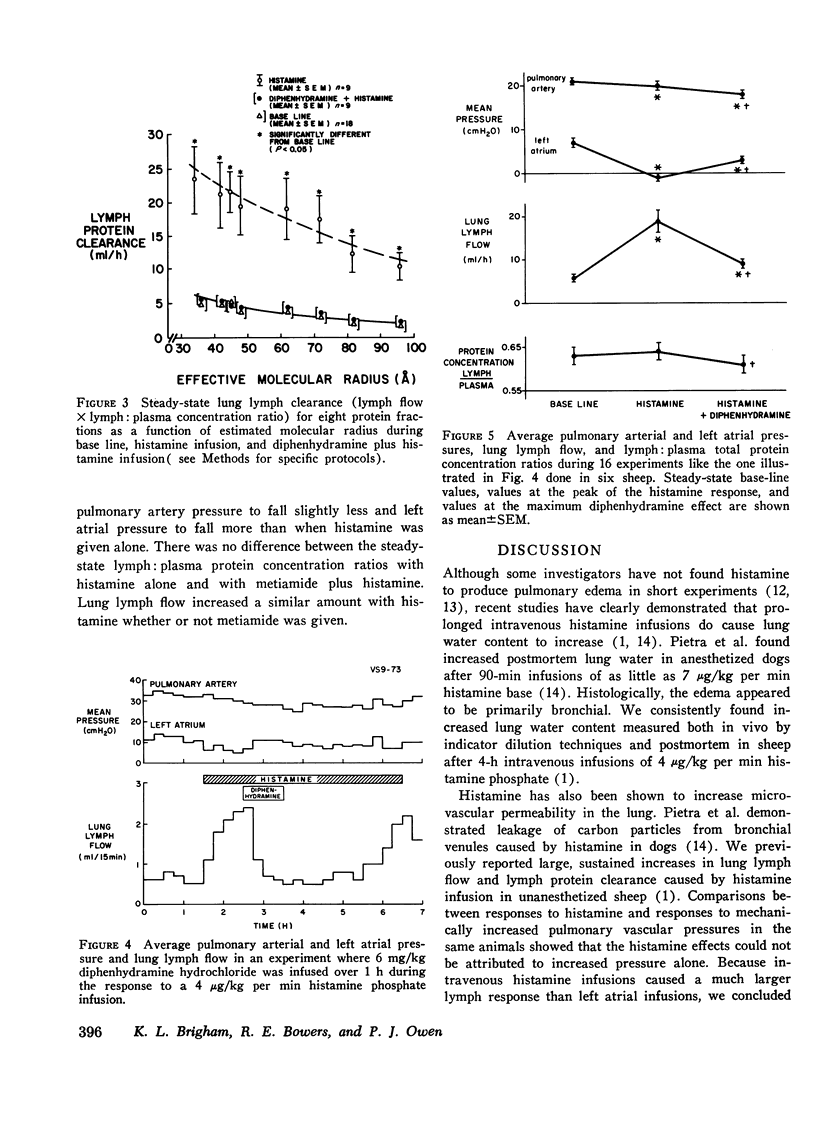
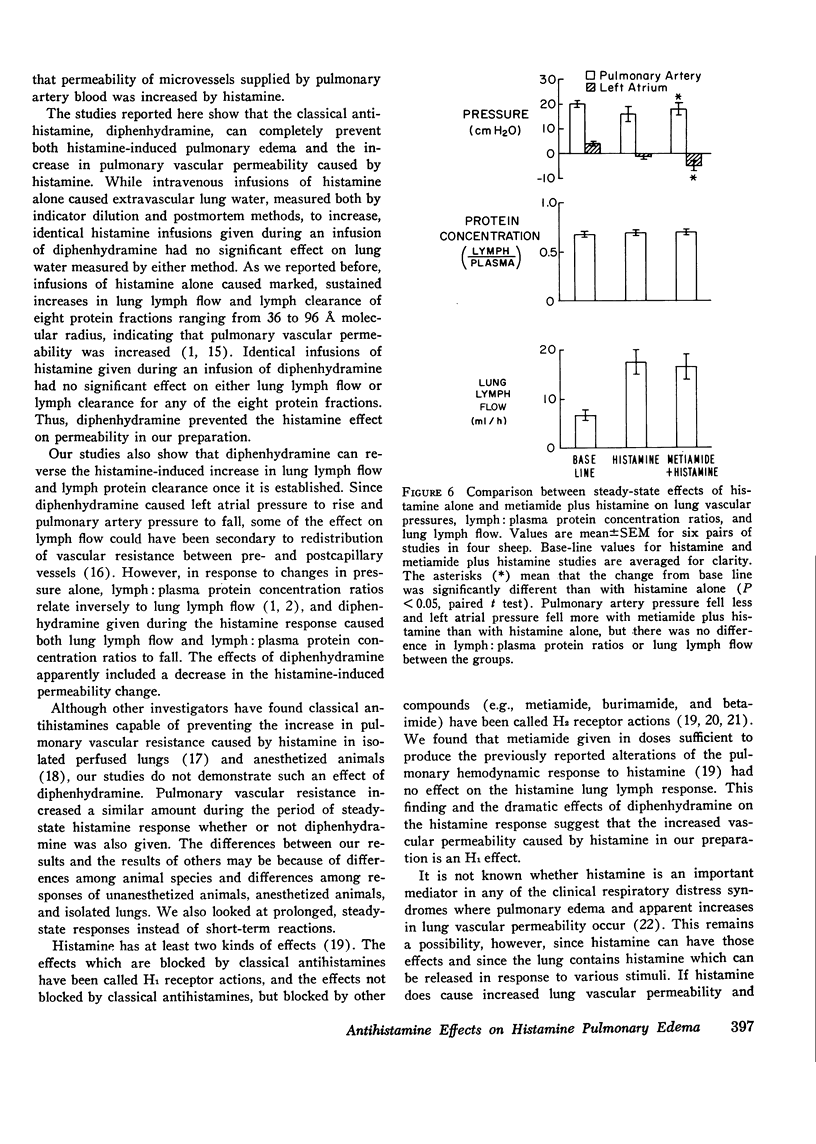
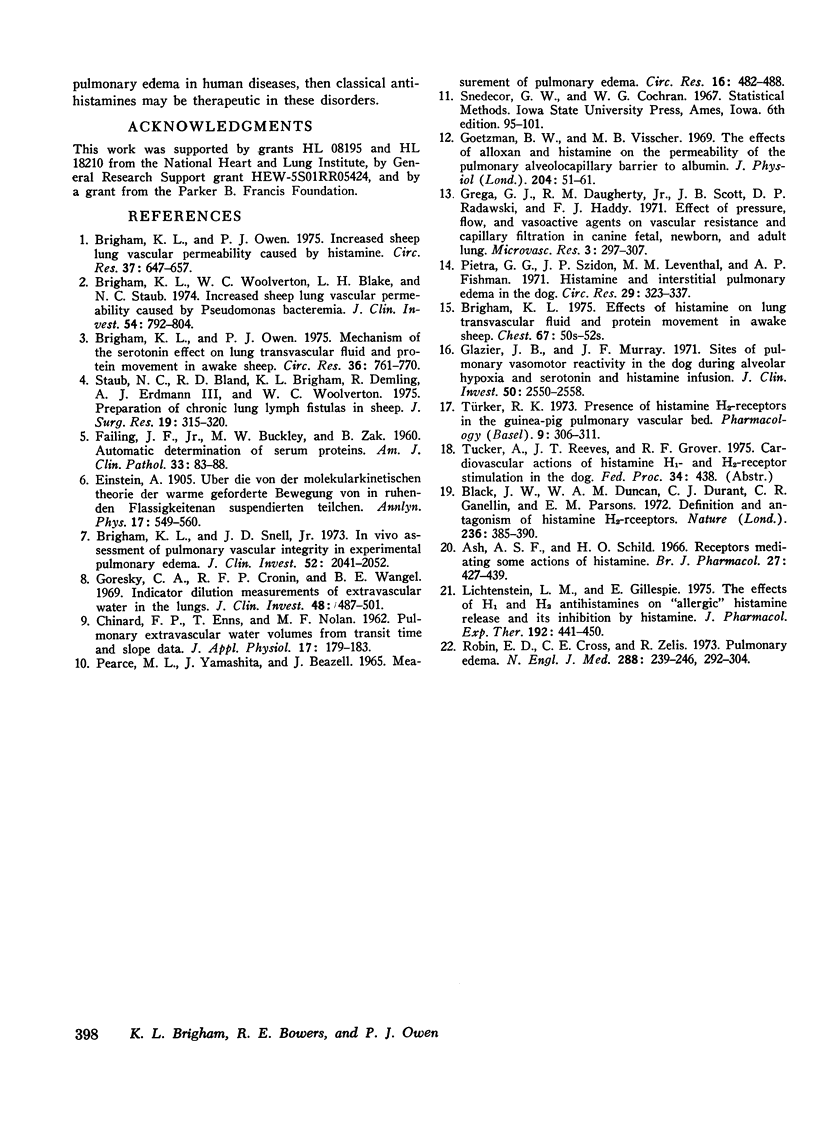
Selected References
These references are in PubMed. This may not be the complete list of references from this article.
- Black J. W., Duncan W. A., Durant C. J., Ganellin C. R., Parsons E. M. Definition and antagonism of histamine H 2 -receptors. Nature. 1972 Apr 21;236(5347):385–390. doi: 10.1038/236385a0. [DOI] [PubMed] [Google Scholar]
- Brigham K. L. Effects of histamine on lung transvascular fluid and protein movement in awake sheep. Chest. 1975 Feb;67(2 Suppl):50S–52S. doi: 10.1378/chest.67.2_supplement.50s. [DOI] [PubMed] [Google Scholar]
- Brigham K. L., Owen P. J. Increased sheep lung vascular permeability caused by histamine. Circ Res. 1975 Nov;37(5):647–657. doi: 10.1161/01.res.37.5.647. [DOI] [PubMed] [Google Scholar]
- Brigham K. L., Owen P. J. Mechanism of the serotonin effect on lung transvascular fluid and protein movement in awake sheep. Circ Res. 1975 Jun;36(6):761–770. doi: 10.1161/01.res.36.6.761. [DOI] [PubMed] [Google Scholar]
- Brigham K. L., Snell J. D., Jr In vivo assessment of pulmonary vascular integrity in experimental pulmonary edema. J Clin Invest. 1973 Aug;52(8):2041–2052. doi: 10.1172/JCI107388. [DOI] [PMC free article] [PubMed] [Google Scholar]
- Brigham K. L., Woolverton W. C., Blake L. H., Staub N. C. Increased sheep lung vascular permeability caused by pseudomonas bacteremia. J Clin Invest. 1974 Oct;54(4):792–804. doi: 10.1172/JCI107819. [DOI] [PMC free article] [PubMed] [Google Scholar]
- Glazier J. B., Murray J. F. Sites of pulmonary vasomotor reactivity in the dog during alveolar hypoxia and serotonin and histamine infusion. J Clin Invest. 1971 Dec;50(12):2550–2558. doi: 10.1172/JCI106755. [DOI] [PMC free article] [PubMed] [Google Scholar]
- Goetzman B. W., Visscher M. B. The effects of alloxan and histamine on the permeability of the pulmonary alveolocapillary barrier to albumin. J Physiol. 1969 Sep;204(1):51–61. doi: 10.1113/jphysiol.1969.sp008897. [DOI] [PMC free article] [PubMed] [Google Scholar]
- Goresky C. A., Cronin R. F., Wangel B. E. Indicator dilution measurements of extravascular water in the lungs. J Clin Invest. 1969 Mar;48(3):487–501. doi: 10.1172/JCI106006. [DOI] [PMC free article] [PubMed] [Google Scholar]
- Grega G. J., Daugherty R. M., Jr, Scott J. B., Radawski D. P., Haddy F. J. Effect of pressure, flow, and vasoactive agents on vascular resistance and capillary filtration in canine fetal, newborn, and adult lung. Microvasc Res. 1971 Jul;3(3):297–307. doi: 10.1016/0026-2862(71)90055-0. [DOI] [PubMed] [Google Scholar]
- Lichtenstein L. M., Gillespie E. The effects of the H1 and H2 antihistamines on "allergic" histamine release and its inhibition by histamine. J Pharmacol Exp Ther. 1975 Feb;192(2):441–450. [PubMed] [Google Scholar]
- PEARCE M. L., YAMASHITA J., BEAZELL J. MEASUREMENT OF PULMONARY EDEMA. Circ Res. 1965 May;16:482–488. doi: 10.1161/01.res.16.5.482. [DOI] [PubMed] [Google Scholar]
- Pietra G. G., Szidon J. P., Leventhal M. M., Fishman A. P. Histamine and interstitial pulmonary edema in the dog. Circ Res. 1971 Oct;29(4):323–337. doi: 10.1161/01.res.29.4.323. [DOI] [PubMed] [Google Scholar]
- Robin E. D., Cross C. E., Zelis R. Pulmonary edema. 2. N Engl J Med. 1973 Feb 8;288(6):292–304. doi: 10.1056/NEJM197302082880606. [DOI] [PubMed] [Google Scholar]
- Staub N. C., Bland R. D., Brigham K. L., Demling R., Erdmann A. J., 3rd, Woolverton W. C. Preparation of chronic lung lymph fistulas in sheep. J Surg Res. 1975 Nov;19(5):315–320. doi: 10.1016/0022-4804(75)90056-6. [DOI] [PubMed] [Google Scholar]


